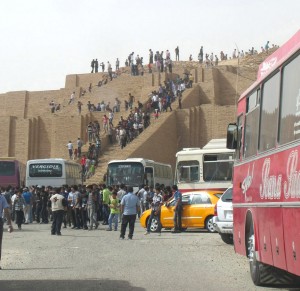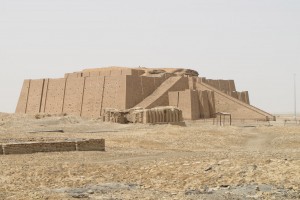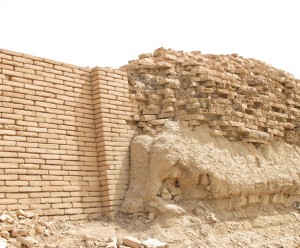 There are very few tourists in Iraq at the moment, so I was expecting the ancient city of Ur to be almost deserted. But no, as we approached the great ziggurat, we saw about 40 tour buses parked and hordes of teenagers cavorting around the site. Say what?
There are very few tourists in Iraq at the moment, so I was expecting the ancient city of Ur to be almost deserted. But no, as we approached the great ziggurat, we saw about 40 tour buses parked and hordes of teenagers cavorting around the site. Say what?
It turns out it’s the last month of the school year, and ancient Ur is a favorite site for local school outings. (This seems like a good thing!) The younger kids also found a visiting Scot a fine additional attraction, so I had to dutifully pose for some group pictures.
 I’m glad they were having fun: drumming, dancing, and maybe even absorbing a little history. But it was also kind of a relief when the buses moved on and we really did have the site to ourselves!
I’m glad they were having fun: drumming, dancing, and maybe even absorbing a little history. But it was also kind of a relief when the buses moved on and we really did have the site to ourselves!
 Ur is very ancient, but the ziggurat, is from only (!) around 2100 bc. Unfortunately it has suffered aggressive modern restoration. The ziggurat core is original, but almost all the outer facing and stairs are an imaginative reconstruction. Near the top, some of the ancient brickwork is visible. Both old and new brickwork was built with included layers of asphalt for water-proofing and flexibility.
Ur is very ancient, but the ziggurat, is from only (!) around 2100 bc. Unfortunately it has suffered aggressive modern restoration. The ziggurat core is original, but almost all the outer facing and stairs are an imaginative reconstruction. Near the top, some of the ancient brickwork is visible. Both old and new brickwork was built with included layers of asphalt for water-proofing and flexibility.
 At a few places near the top it’s possible to see the pristine new “restored” walls melding into battered original sections.
At a few places near the top it’s possible to see the pristine new “restored” walls melding into battered original sections.
There are a number of other excavated buildings, including the Royal Cemeteries of Ur and a large (reconstructed) residential building, rather optimistically identified as “Abraham’s House”.
And here are some overall tour notes.